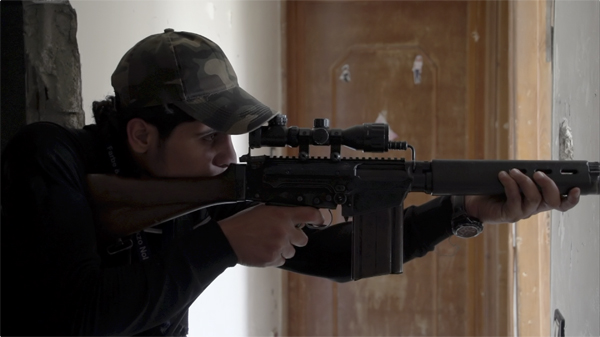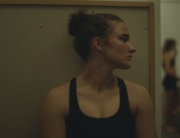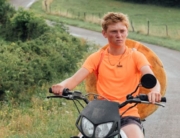Two films in this year’s New Directors/New Films program represent the breed of hybrid blending of fact and fiction that both of its sponsoring institutions are also championing in separate annual series, the Museum of Modern Art in its just completed Documentary Fortnight International Festival of Nonfiction Film and Media and the Film Society of Lincoln Center in its upcoming Art of the Real. Purists will question what is true or not (the issue goes back to Robert Flaherty’s 1920’s documentaries), but both films get to an observational anthropological essence.
Stop the Pounding Heart is the culmination of Roberto Minervini’s trilogy over the past three years from his embedding with insular rural Texas communities in the Christian Bible Belt that outsiders rarely see this sympathetically. Inspired by how his fellow Italian neorealists used non-professionals to portray their lives, Minervini focuses here on two 14-year-olds who were secondary characters in the earlier films (that had limited festival exposure in the U.S.). They continue to play some achingly intimate version of themselves that feels credibly realistic.
Sara (Sara Carlson) lives in a very strict fundamentalist community of Bible-based home schooling, and she cares for an ever growing brood of siblings and goats. She glimpses the outside world only from the artisanal dairy products stand at farmers’ markets. Colby (Colby Trichell), a lanky ambitious bull rider, could have been the prototypical bad boy temptation down the road. But he is also religious in his fashion, totally obsessed as the cowboy in the Judy Collins’ song who loves his damn old rodeo more than his girlfriend, and he doesn’t seem more interested in the aggressive tattooed chicks by the chutes.
The key, albeit subtle, tension comes from Sara’s shyly inarticulate struggle with adolescent rebellion, and Minervini captures well her proto-feminist frustration that no one listens to her. Certainly not her mother, who intones subservience as freedom. (Ironically, she rebelled against her parents by settling on this lifestyle). Not even the hesitantly flirtatious boy realizes that the real way to the heart of this pretty girl would be to just let her ride a horse.
The Vanquishing of the Witch Baba Yaga is a marvelously cinematic challenge to Bruno Bettelheim’s Freudian analysis of fairy tales. It interprets them more broadly through the prism of history and environment. Director Jessica Oreck says she specializes in ethnobiology documentaries on “the way human cultures interact with the natural world,” as seen in last year’s Aatsinki: The Story of Arctic Cowboys that followed a year in the life of Finnish reindeer herders. But deep in the forest primeval of Eastern Europe, she seeks out the roots of folklore, the transmissions of mythic fears, and people’s endurance in a region beset by centuries of conflict.
Her search through the region today for traces of the past is interspersed with chapters in a Russian-narrated, colorful animation of the scary stories I grew up with the witch in the house on tall chicken legs who chases down children (as in “Baba Yaga will get you if you don’t watch out!”). Here, a young brother and sister are sent fleeing from soldiers attacking their village into the path of Baba Yaga, who keeps threatening to eat them unless they fulfill impossible tasks that magical animals help them accomplish. Throughout are lots of grandparents teaching children traditions in how to be nourished by spirituality and nature, like picking the right mushrooms. Oreck has found the very source of storytelling.
Return to Homs, the most straight-forward documentary in the program, unfolds as one of the most thrilling stories that deserves a Hollywood tagline like “A hero will rise.” Over two years, Syrian director Talal Derki went to the heart of the protests against the regime of President Bashar al-Assad and filmed close up, where international journalists could not, as the peaceful Arab Spring protestors are radicalized and hardened under a barrage of bombs and sniper bullets that wreck apartments and kill people before our eyes. (Several cameramen are memorialized as “martyrs” in the credits.) He focuses on two handsome, charismatic young men, in particular.
Abdul Basset al-Saroot is first seen as a 19-year-old top soccer prospect joyfully turning sports chants into political anthems. His boyhood friend Usama is more comfortable keeping quiet behind a camera, daring to be the revolution’s official videographer—he’s now missing in action. Their heated debates on pacifism vs. violence have frighteningly real ramifications while they grow into their roles as guerrilla leaders during a brutal siege that has provoked an international refugee crisis. The closest to any insight on the tensions behind the conflict, though, is when a hysterical woman flees a wrecked building screaming, “The Alewites are killing us!” (All are clearly Muslim, of various levels of observance.) The immediacy of the horror of the continuing urban civil war is overwhelming.

















Leave A Comment